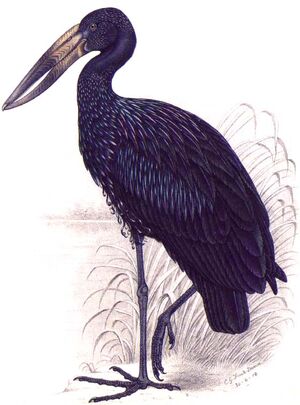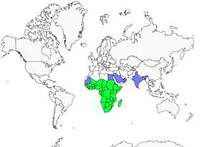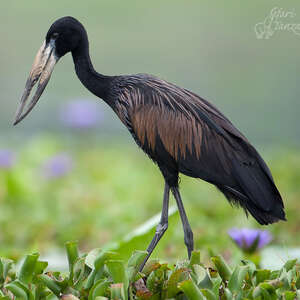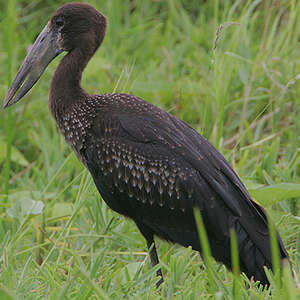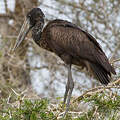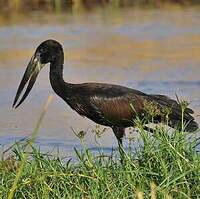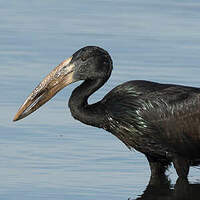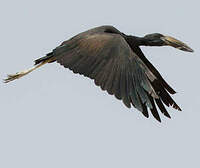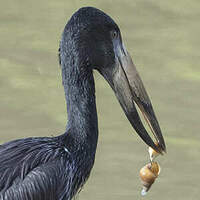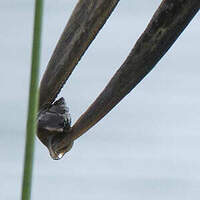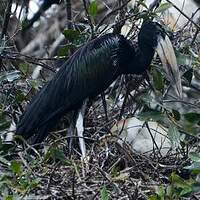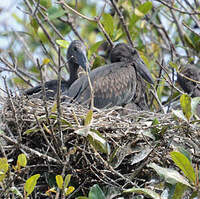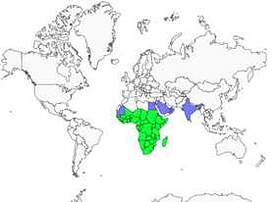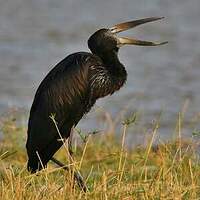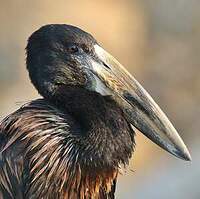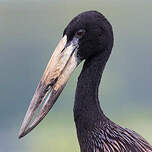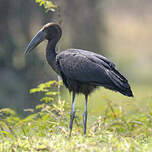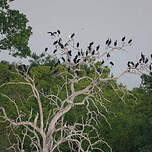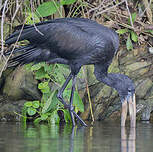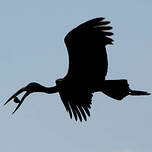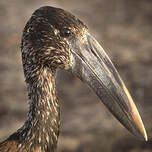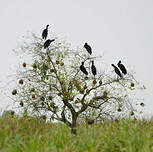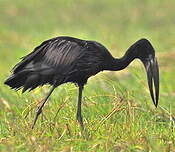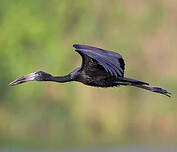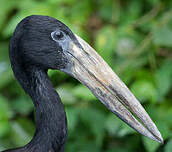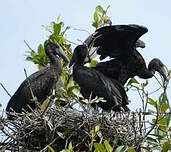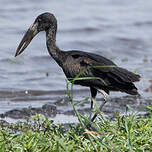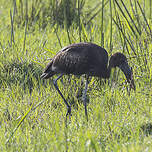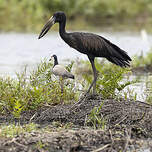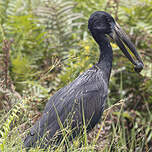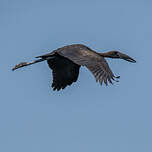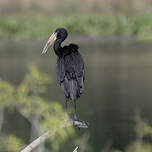African Openbill
Anastomus lamelligerus - Bec-ouvert africain
Identification
The African Openbill is a wading bird of the stork family, of the genus Anastomus, which it shares only with the Indian Openbill. At a maximum of 94 cm in length, it is a medium-sized stork, slightly smaller but much lighter than the White Stork. As with most storks, there is no sexual dimorphism, except that males are usually larger than females.
The plumage can appear to be generally black, especially from a distance. But seen up close in good light, adult birds in breeding plumage show elongated, ornamental feathers on the lower neck, upper chest, mantle, and scapulars with beautiful green, brown-red, or violet metallic reflections.
As its name implies, it is its bill that characterizes it and allows easy identification. This bill, long and strong, horn-colored at its base and darker in its second half, is adapted to the very specialized nutrition of the species. The lower mandible is only in contact with the upper one on the proximal half of the bill and at its tip at one point, leaving an oblong opening with a maximum height of 6 mm in the distal part.
The legs are gray, the eyes brown, surrounded by a bare blue skin that joins the lores also bluish.
The immature resembles the adult but duller, more brown, with fewer reflections, and has a straighter bill, with little or no space between the two mandibles. It takes several years for the bill to acquire its definitive shape.
Subspecific information 2 subspecies
- Anastomus lamelligerus lamelligerus (Africa south of the Sahara)
- Anastomus lamelligerus madagascariensis (Madagascar)
Foreign names
- Bec-ouvert africain,
- Picotenaza africano,
- bico-aberto-africano,
- Glanzklaffschnabel,
- afrikai tátogatógólya,
- Afrikaanse Gaper,
- Anastomo africano,
- afrikansk gapnäbbsstork,
- Afrikagapenebb,
- škározobec tmavý,
- zejozob africký,
- Afrikansk Gabenæb,
- afrikanrakonokka,
- Oopbekooievaar,
- bec de tenalla africà,
- kleszczak afrykański,
- Африканский аист-разиня,
- クロスキハシコウ,
- 非洲钳嘴鹳,
- afrikansk gapnäbbsstork,
- 非洲鉗嘴鸛,
Voice song and call
The African Openbill is silent when alone, but produces rough sounds in groups when in contact with other individuals. This is particularly the case in reproductive colonies between partners and/or rivals. Young nestlings emit incessant begging cackles. It cannot clap its beak like other storks due to the shape of its beak, but pecks between congeners can produce similar sounds.
Habitat
The African Openbill is tied to fresh water. It is most often found on the edge of a lake, in marshy areas, preferably bordered by big trees which serve as its perches and are necessary for its reproduction. Occasionally, during a wet season, it can be found in flooded savannahs, or any area where its food is available.
Behaviour character trait
The African Openbill is gregarious throughout the year. It can sometimes be found in large numbers in the trees bordering the bodies of water. Reproduction is arboreal and colonial. However, while it lives and moves in a group, it feeds alone. In fact, it searches for mollusks, immobile prey that does not require cooperation. Depending on the populations, it is sedentary or a seasonal migrant.
Flight
Dietfeeding habits
The African Openbill largely feeds on aquatic mollusks, mainly the Gastropods from the genera Pila and Lanistes and the Bivalves from the genus Ampullaria.
It is reported that in Uganda it consumes terrestrial snails Limicolaria martensiana. Its technique, related to its anatomy, is highly specialized. Walking slowly in shallow water, it spots its prey by sight or touch, usually a Gastropod which its particular beak extracts from the shell, with its lower mandible sectioning the muscle keeping the animal inside. A similar technique allows it to open fresh water mussels, with its lower mandible detaching the two valves of the shell. Occasionally, it may, in an opportunistic way, consume other prey such as small amphibians, various invertebrates etc., but this still needs to be documented.Reproduction nesting
The African Openbill breeds during the rainy season. In East Africa, breeding occurs from January to March, but in Zambia, it can be observed at any time of year, probably due to the abundance of food.
After a parade resembling that of other Ciconiids, the formed pair builds a nest composed of branches and reeds, usually in a tree. This nest, relatively small, about 50 cm in diameter, is lined with aquatic vegetation.
The female lays 3-4 eggs. After an incubation period of 25-30 days, the chicks are born completely black, with a straight, classical-shaped beak. They are apparently fed almost exclusively on molluscs. They leave the nest after 50-55 days. Reproductive success is about 1 young per couple per year.
Geographic range
The African Openbill can be found in Sub-Saharan Africa, from where it stretches along the Sahelian border to the north and as far south as Northern Namibia and Botswana. It is primarily located in the east of the continent with a particular population center in Kenya heading towards Zambia. There is no finding of the species to the west of its range and it is absent from the forested region in the west-centre. A subspecies is located in the north-west of Madagascar. After the breeding season, eastern birds migrate northwards and westwards, but they never reach Western Africa where the species is rarely seen. Those in the south of the continent are more sedentary.
Threats - protection
IUCN conservation status
concern
in the Wild
threatened
evaluated
The species is not currently considered to be globally threatened. It can be locally abundant if the environment and climate conditions are suitable. However, it is declining continent-wide. As is the case with many species, the main cause of this is loss of habitat, but the use of insecticides in malaria control is also blamed. Negative factors such as hunting and traditional medicine in Nigeria are also mentioned. The subspecies of Madagascar has recently declined in numbers and its range of presence has been reduced due to the destruction of colonies by villagers.
Sources of information
- IOC World Bird List (v15.1), Gill, F and D Donsker (Eds). 2025-12-07.
- Birds of East Africa: Kenya, Tanzania, Uganda, Rwanda, Burundi, Terry Stevenson, John Fanshawe
- Storks; ibises and spoonbills, James Hancock, James Kushlan et Philip Kahl
- HBW Alive,
Other sources of interest
 Specification sheet created on
29/07/2023 by Catherine et Bernard Lanneluc
Specification sheet created on
29/07/2023 by Catherine et Bernard LannelucTranslation by AI Oiseaux.net
© 1996-2026 Oiseaux.net
- Accipitriformes
- Aegotheliformes
- Anseriformes
- Apodiformes
- Apterygiformes
- Bucerotiformes
- Caprimulgiformes
- Cariamiformes
- Casuariiformes
- Charadriiformes
- Ciconiiformes
- Coliiformes
- Columbiformes
- Coraciiformes
- Cuculiformes
- Eurypygiformes
- Falconiformes
- Galliformes
- Gaviiformes
- Gruiformes
- Leptosomiformes
- Mesitornithiformes
- Musophagiformes
- Nyctibiiformes
- Opisthocomiformes
- Otidiformes
- Passeriformes
- Pelecaniformes
- Phaethontiformes
- Phoenicopteriformes
- Piciformes
- Podargiformes
- Podicipediformes
- Procellariiformes
- Psittaciformes
- Pterocliformes
- Rheiformes
- Sphenisciformes
- Steatornithiformes
- Strigiformes
- Struthioniformes
- Suliformes
- Tinamiformes
- Trogoniformes

